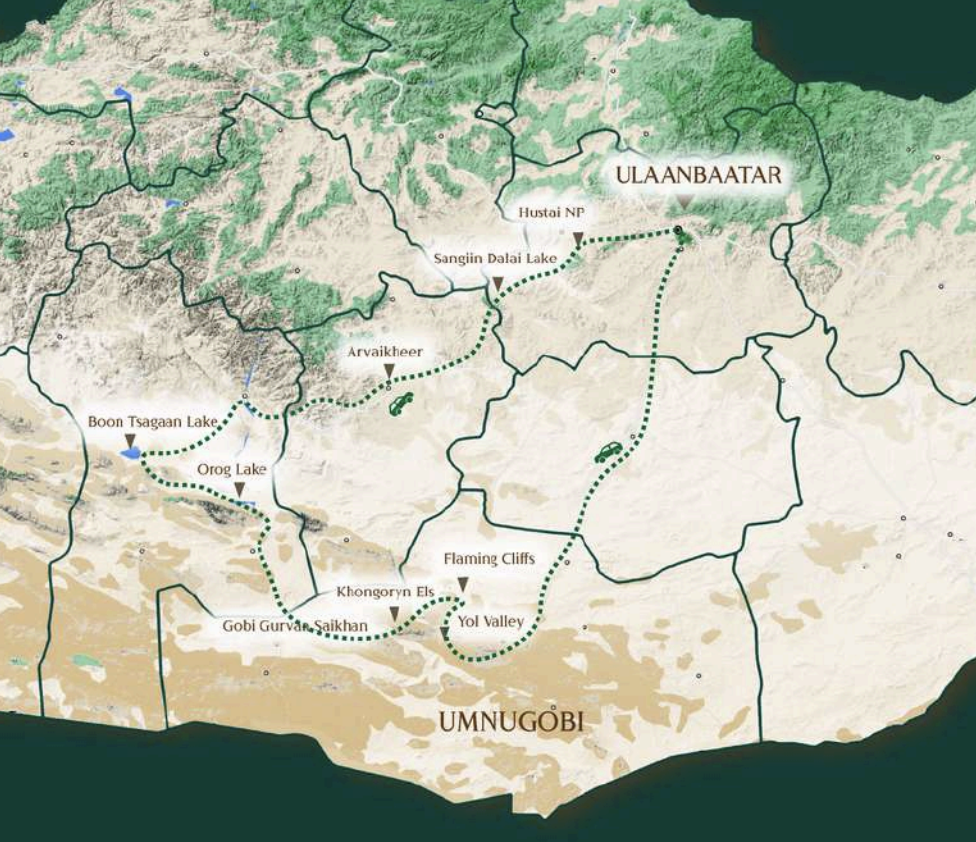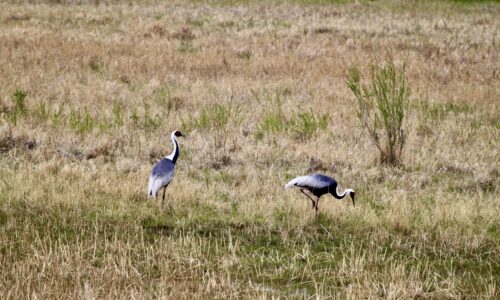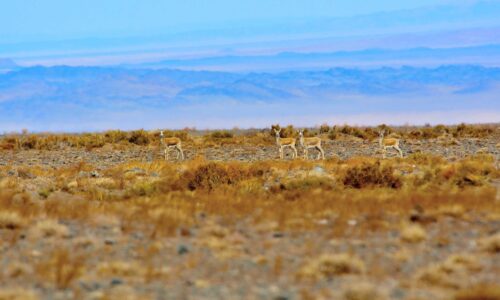WILDLIFE SAFARIS
Birding in the gobi, steppe and high mountains of Mongolia
Date: June 2 - 16, 2026
TRIP SUMMARY
The Gobi Desert and Central Mongolian grasslands are home to some of Mongolia’s most diverse and endemic bird species. While exploring the valleys, slopes, and ridges, you may encounter a wide range of mountain species, including: Bearded Vulture (Lammergeier), Chukar Partridge, Himalayan Griffon, Cinereous Vulture, Booted and Golden Eagles, Water Pipit, Black Redstart, Alpine Accentor, Brown Accentor, nearly endemic Kozlov’s Accentor, Chinese Beautiful Rosefinch, Twite, Godlewski’s Bunting, Pallas’s Reed Bunting, Common Rock Thrush, and with luck, Grey-necked Bunting, Red-mantled Rosefinch, and Spotted Great Rosefinch.
In the Yol Valley, flocks of White-winged Snowfinches are often seen confidently feeding along the trail. Further north, Boon Tsagaan Lake, covering 252 km² at 1,312 m above sea level, is the largest lake in the Valley, measuring 24 km in length and 11 km in width with an average depth of 9.6 m. It is a prime site for watching Relict Gull, Pallas’s Fish Eagle, Dalmatian Pelican, Mute Swan, and various waterfowl and waders. The lake supports several globally threatened species and is a crucial area for their breeding and congregation before migration. The trip concludes at Hustai Nuruu National Park, one of Mongolia’s best-managed conservation areas, known for its unique animal kingdom.
TRIP HIGHLIGHTS
WHAT YOU CAN EXPECT...
- Stunning Landscapes: Explore the Gobi Desert, grasslands, and valleys.
- Unique Wildlife: Spot rare and endemic birds like the Bearded Vulture and Golden Eagle.
- Cultural Immersion: Stay in authentic ger camps with Western amenities.
- Comfortable Stays: Cozy expedition-style tents and well-equipped camps.
- Expert Guidance: Experienced drivers and knowledgeable guides.
- Scenic Drives: Reliable Toyota Land Cruisers for rugged terrain.
- Starry Nights: View the northern stars and the Milky Way.
THIS TRIP IS PERFECT FOR:
- Nature Lovers: Appreciate diverse ecosystems and wildlife.
- Birdwatchers: See rare and endemic bird species.
- Adventurers: Unique, off-the-beaten-path experiences.
- Cultural Enthusiasts: Experience traditional Mongolian lifestyle.
- Photographers: Capture stunning landscapes and wildlife.
- Conservationists: Learn about managed wildlife areas like Hustai Nuruu National Park.
MAP & ITINERARY
Ulaanbaatar is the capital of Mongolia, located on the basins of Tuul River valley. It is nestled on the foothills Bogd Khan Uul National Park on its outhern part. Originally a nomadic Buddhist center, it became a permanent city in the 18th century. A Soviet-era influenced architecture co-exists with old monasteries and 21st-century highrises. Enjoy a short city tour followed by a welcome dinner at a fine local restaurant.(Hotel Kempinski or similar; D)
In the morning, we will begin driving south to the mighty Gobi Desert (7-8 hours). En route, we will stop to have a lunch at a road cafe. In the afternoon, arrive at the ger camp and overnight in gers. (Ger camp; B, L, D)
Over the next two days, we will explore Gobi Gurvansaikhan National Park, home to stunning landscapes and diverse wildlife. In the Zuun Saikhan Mountain Range, we’ll look for birds like the Saker Falcon, Altai Snowcock, and Golden Eagles. Afterward, we’ll travel to the Flaming Cliffs, a site famous for dinosaur fossil discoveries. Along the way, we’ll see species like the Henderson’s Ground Jay and Pallas’s Sandgrouse. We’ll stop at an oasis to photograph the birds and enjoy the breathtaking scenery before returning to camp for dinner.(Ger camp; B, L, D)
After breakfast, we’ll head to Khongoryn Els, home to the Gobi’s largest sand dunes, stretching 300m high and 100km long. The area features rocky mountains, vast dunes, and a river oasis. Birding highlights include Saxaul Sparrow, Southern Grey Shrike, Long-legged Buzzard, and Mongolian Ground Jay. We’ll also explore a colony of Lesser Kestrels over two days. (Ger camp; B, L, D)
We’ll head north across the rugged Nemegt Valley, stopping for birding at spots like Saxaul Sparrow, Southern Grey Shrike, and Mongolian Ground Jay. In the coming days, we’ll explore the Ramsar-designated Valley of Lakes, with its semi-desert lakes, Boon Tsagaan and Orog, at the foot of the Gobi Altai. We’ll set up camp at Orog Lake and have optional birding at the eastern shore. (Tent camp; B, L, D)
We’ll spend a full day birding at Ikh Bogd Mountain, the highest peak in the Gobi Altai range at 3,957m. This sacred site is known for its steep slopes, rocky terrain, and sparse vegetation. We’ll hike to the ridge to search for high-altitude birds like Lammergeier, Himalayan Griffon, Altai Snowcock, and the rare White-throated Bushchat. Other species include Snowfinches, Buntings, and Chukars. We may also spot Siberian Ibex and Argali. In the evening, we’ll head north through a scenic gorge towards Orog Lake.(Tent camp; B, L, D)
For the next two days, we will visit Boon Tsagaan Lake, the largest in the Valley, covering 252 km² at an altitude of 1,312 m. The lake is known for its rich birdlife, especially globally threatened species like the Relict Gull, Pallas’s Fish Eagle, Dalmatian Pelican, and Mute Swan. It also serves as a crucial breeding and migration stop for various waterfowl and waders. The surrounding semi-desert landscape is sparsely vegetated, and the Baidrag River is its main water source. We will camp near the river’s estuary and explore the lake’s wildlife. (Tent camp; B, L, D)
After breakfast, we will head to Arvaikheer city in Uvurkhangai province, driving through the grassland region. We will have lunch at the restaurant in Bayankhongor city in Bayankhongor province. After lunch, we will do a short birding stop at Tuin river, located close to the city. Then visit to Arvaikheer city for overnight and overnight at hotel. (Local Hotel; B, L, D)
After breakfast, we’ll visit Sangyn Dalai Lake, home to Whooper Swans, Demoiselle Cranes, Stejneger’s Scoters, Horned Grebes, and the endangered Falcated Duck. The lake’s shores also host Mongolian Larks and Pere David’s Snowfinches. We will explore other nearby lakes before returning to the ger camp for the night. (Ger camp; B, L, D)
Hustai National Park, 100 km west of Ulaanbaatar, is renowned for the successful reintroduction of Przewalski’s wild horses. It also hosts red deer and Siberian marmots. The park is home to steppe birds like Upland Buzzard, Demoiselle Crane, and Steppe Eagle. You’ll stay in gers and dine at a local restaurant. (Ger camp; B, L, D)
After birding around the park, we will leave the site and return to Ulaanbaatar, checking in to a hotel for our last night in the country.The afternoon is free for individual sightseeing and shopping. In the evening, we will enjoy a traditional Mongolian performance followed by a festive dinner to celebrate our adventures in Mongolia. Overnight at hotel. (Hotel Kempinski or similar; B, L, D)
After breakfast transfer to the airport for your return flight home. (B)
PRICING
- Land transportation using a 4×4 van and land cruisers; A
- ccommodation in standard rooms at hotel and standard ger camps throughout;
- Expedition style tents, sleeping bags and mats;
- Airport arrival & departure transfers;
- All meals indicated as B, L or D;
- All entrance fees as indicated in the itinerary;
- Camel and horse riding fees; Mongolian ornithologist or a study leader;
- English speaking guide throughout your stay with local knowledge and experience;
- One soda per person per meal;
- Supply of bottled water per person per day based on consumption.
- International airfare;
- Personal laundry;
- Drinks not mentioned in the itinerary;
- Travel insurance;
- Medical evacuation costs;
- Excess baggage charges;
- Visa fees;
- Gratuities;
- Photography and video fees;
- Any other item not mentioned as included.





